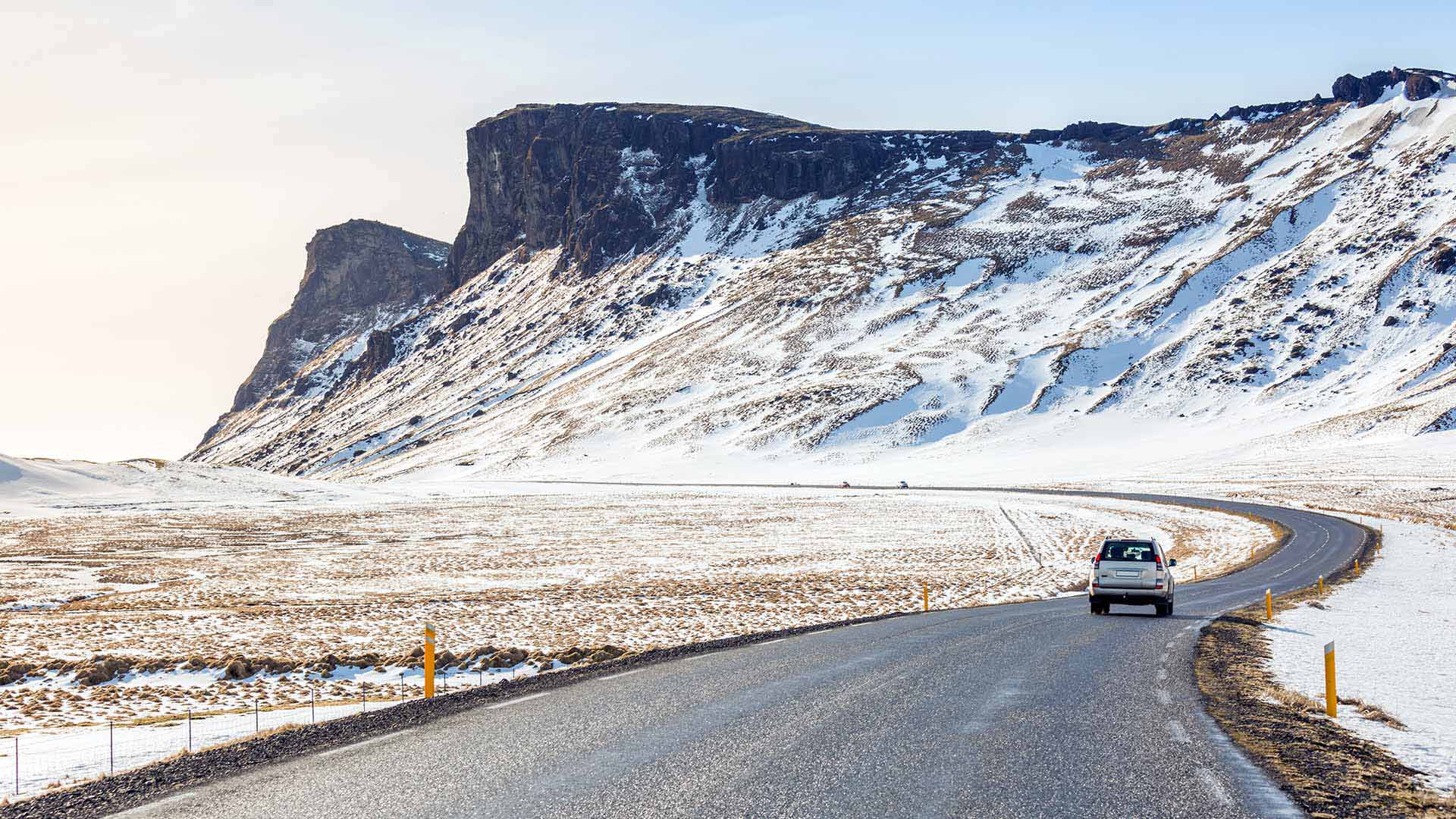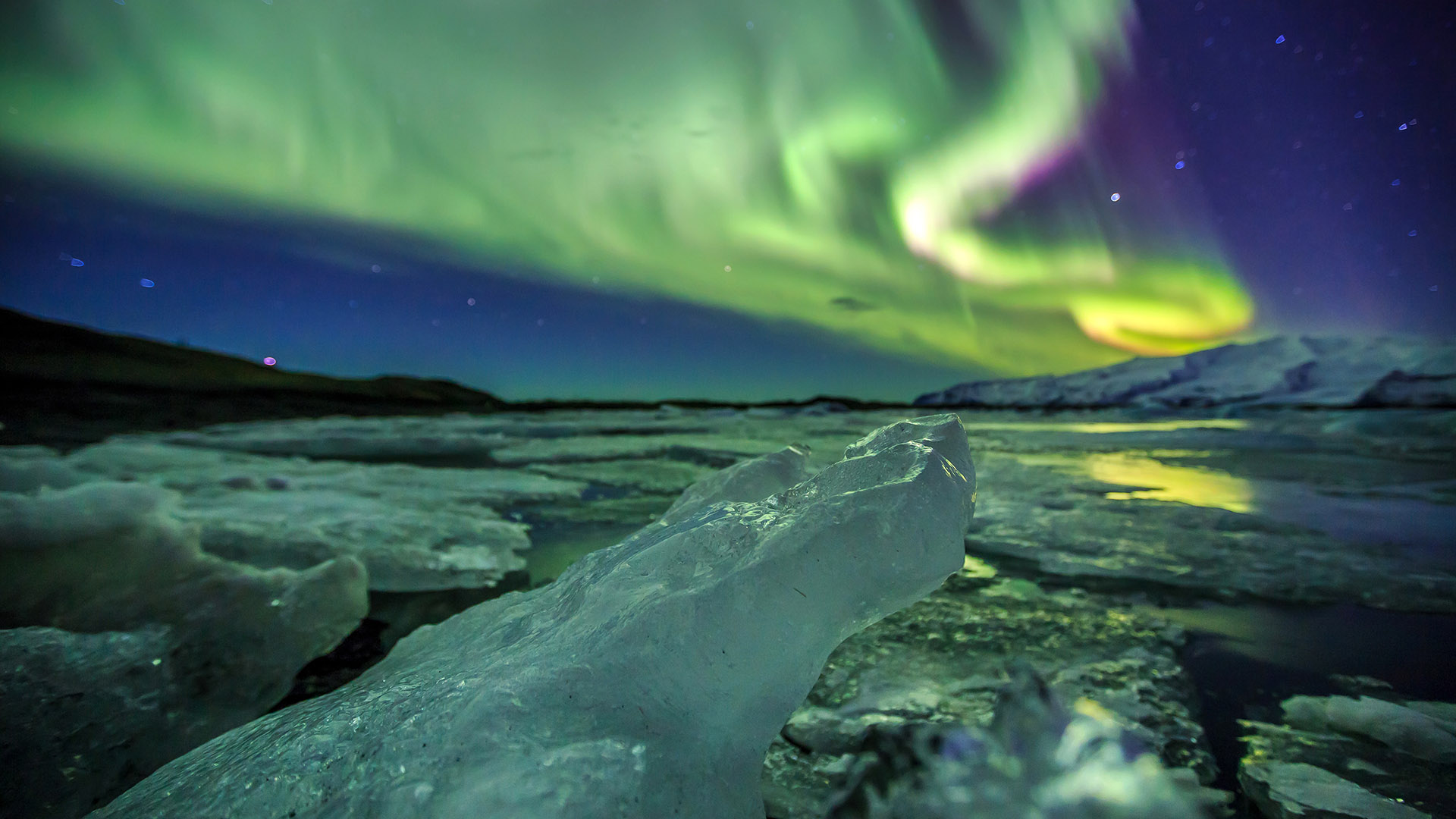Iceland is like nowhere else on earth. It’s a land where glaciers, hot springs and waterfalls reign supreme. A place where adventures abound. Where you can experience four seasons in a day, and drive around the island in a full circle.
If you’re thinking about visiting Iceland, you’ve probably got questions about the practical side of your trip. For example, when you should go, the different ways to travel in Iceland, and what the weather’s like.
That’s why we’ve put together some Iceland travel tips that cover everything from packing lists to car rental, ensuring that you make the most of this incredible country.
Contents: Iceland Travel Tips

1. When to go to Iceland
The good news is that there is no “bad time” to explore Iceland! Every season offers something different, and the country’s raw nature is always breathtaking no matter which month you visit.
Iceland in summer
Visit Iceland in the summer to experience one of our planet’s most exceptional natural spectacles: the midnight sun. Between May and August, Iceland’s northerly location keeps the sun above the horizon around the clock.
- Browse these tours of Iceland in summmer
- Related: Reynisfjara black sand beach – Your guide
At this time of year, Iceland is all lush greenery and long summer evenings. The weather is pleasantly mild, with Reykjavík temperatures averaging 13°C (55°F) in July and August – perfect for a day out exploring the black-sand beaches.
Combine the weather with long days and excellent driving conditions, and you have the perfect recipe for a jam-packed sightseeing tour.
Iceland in winter
A trip to Iceland in the winter months might treat you to snow-dusted scenery and – if you’re lucky – a glimpse of the aurora borealis. Although a display of the northern lights is never guaranteed, October to March is the optimum time to seek out this natural phenomenon.
Additionally, visiting Iceland at this time of year means you can enjoy winter activities. You’ll have the opportunity to go snowmobiling, hike across glaciers, and explore ice caves.
Kept temperate by the Gulf Stream, Iceland’s winter climate is never extreme, although you might experience sub-zero temperatures in January and February.

Iceland in the shoulder season
Another option is to visit in the spring or autumn. In April and September, Iceland is quieter as there are less people at top attractions and the traffic is lighter. The days are also longer than in winter and there is more availability for accommodation.
- Discover Iceland in summer, winter or the shoulder season on one of these best-selling Iceland tours
2. Tips for travelling around Iceland
There are various ways you can travel around Iceland. You could explore the island on a road trip, or let someone else take the wheel on a private or multi-day tour. Another option is to join a small group, accompanied by a knowledgeable guide.

How to travel around in summer
If you’re keen on the idea of a self-driving tour of Iceland, summer is the best time to visit. The long days and mild weather make for a straightforward driving experience, particularly if you’re sticking to main routes such as the Ring Road or the Golden Circle.
If you’re keen to get up into the Highlands, be aware that proper planning and access to a 4x4 vehicle is essential. For a more relaxing experience, book onto one of our private tours and let someone else drive you there.
Driving aside, summer is a great time to explore Iceland on foot or by bicycle. Weather permitting, you can enjoy some fantastic hikes and bike rides through the countryside.
How to travel around in winter
Travelling around Iceland in the winter is more challenging than in the summer – but you shouldn’t be put off! You can still enjoy a road trip in Iceland – just make sure you are prepared with these winter driving tips.
For any Highlands excursions, a modified vehicle known as a super-jeep is required, along with an experienced driver. It’s worth noting that many mountain roads are closed completely during the winter, due to heavy snowfall.
On the other hand, a small group tour is a great option if you would prefer not to drive. Join a few other like-minded travellers and learn from an expert guide. Or, enjoy a private experience and have your personal tour guide show you around Iceland.
An alternative is to choose a multi-day tour in Iceland. You can base yourself in cities like Reykjavík and Akureyri, then head out on day tours to Iceland’s attractions. You can still enjoy many of the country’s top highlights but have a tour guide take you there.
- Read more on the best ways to travel in Iceland
3. Driving in Iceland
Interested in a road trip around Iceland? Here are our insider driving tips.

Renting a car
To rent a car in Iceland, you must hold a driving licence that has been valid for at least one year. You also have to be over 20 years of age, or 23 if you are hiring a four-wheel drive.
Before setting off, make sure you’re clear on the terms of your rental agreement, such as mileage, Collision Damage Waiver and the number of authorised drivers. Check that the vehicle you’re hiring is equipped and insured for the journey you intend to make.
Many regular rental cars will not be suitable for use in the Highlands, so driving on these roads may invalidate your rental agreement.
To make driving in Iceland that much smoother for you, opt for a rental car that comes with unlimited Wi-Fi included.
Unless you are travelling solo, check that a second driver is authorised too. This is a real bonus when you want a break from being behind the wheel!
Using GPS
When driving in Iceland, it’s vital that you plan your route before setting out on your road trip. In the car, make sure you have a reliable GPS to help guide you on your way. You can also use your mobile's maps through the free in-car Wi-Fi.
Many place names in Iceland are difficult to spell or are similar to others. This means your GPS may end up providing the wrong directions. That’s why you should use a GPS with Icelandic lettering so that you can type in the correct name.
Additionally, it’s a good idea to use a paper map as a back-up, rather than relying solely on the GPS. You can annotate the places you want to stop off at by hand so you know exactly where you’re headed.
Good to know: Our Iceland self-drive tours provide you with unlimited in-car Wi-Fi and a hand-marked map of your route, included in the itinerary price.

Stopping at gas stations
Gas stations are plentiful in most areas of Iceland. However, make sure that you have enough petrol in the tank for drives through remote, rural areas.
One of the biggest gas station chains in the country is N1, which also provides kiosks selling food, drink and other essentials. Other brands include Orkan, ÓB and Atlantsolía.
Though many are staffed, it’s also common to come across self-service gas stations with automated pumps. To use these pumps you’ll need a credit or debit card with a four-digit PIN. As an alternative you can buy prepaid N1 cards to use at these automated pumps.
Be aware that there are relatively few gas stations between Vík and Mývatn. When taking a road trip through this region, or any other that is sparsely populated, it’s a good idea to top up on fuel whenever you can.
Winter driving in Iceland
If you’re driving through Iceland between October and April, there are a few key things to bear in mind. You should drive slowly to avoid unseen ice, and keep your headlights on, even in daylight.
Weather and road conditions can change quickly during the winter, so you should check the latest updates before hitting the road. The Icelandic Road and Coastal Administration and SafeTravel are two excellent resources.
Additionally, for peace of mind you could download SafeTravel's 112 Iceland app. This locates your vehicle if you require any assistance on the road.
You can read more of our winter driving advice before you travel.
- Hit the road on a self-drive tour of Iceland in winter
4. Weather
Though the name may suggest otherwise, Iceland is not draped in snow year-round. Overall, the climate is fairly mild and wet.
The warmest months are July and August, when temperatures creep into the mid-teens, while the coldest months are January and February, when the thermometer can dip below zero.

Packing list
Year round, the rain comes and goes and the winds can be strong, so it’s a good idea to bring the following, whenever you travel:
- Plenty of light layers
- Waterproof, wind-resistant jacket
- Warm fleece or sweater
- Walking shoes
- Gloves, scarf and hat
- Swimsuit (essential for the hot springs!)
In addition to the essentials described above, the remainder of your packing list might include clothing and footwear for hiking in the Highlands. For example, thermal underwear, hiking boots and warm socks. You may also want to pack a quick-dry towel, which is useful for visiting hot springs.
Lastly, make sure you organise travel insurance, ensuring that it covers you for your flights and all the activities you want to enjoy in Iceland.

Packing for winter
Winter can bring cold temperatures, occasionally dipping below freezing, as well as snow and wind. To fend off the chilly gusts, we recommend bringing a properly insulated jacket.
In addition, you might consider bringing shoes with anti-slip soles as pavements can become icy during the coldest months.
Packing for summer
To ensure a good night’s sleep during the summer months – when the sun barely goes down – it’s a good idea to pack an eye-mask. During the day, sunglasses and sun lotion are recommended, especially if you’re spending a lot of time outdoors.
Insect repellents can also come in handy when travelling through or staying in waterside regions such as Mývatn. Iceland may be one of the few countries in the world with no mosquitoes, but it’s definitely home to other insects!
- Need more packing advice? Read our in-depth guide on what to pack for Iceland
5. Money and currency
Here are some key things to know about money in Iceland before you go.

Currency in Iceland
The currency in Iceland is the Icelandic Króna (ISK). You can check the exchange rate online using the XE tool.
Using credit cards
Credit and debit cards are widely used in Iceland, even for small purchases. This means that you don’t need to worry about carrying lots of cash on you.
However, if you’d like to withdraw cash and exchange money, banks are located throughout Iceland. They are typically open Monday to Friday.
In addition, because Iceland uses the chip-and-pin system, it’s vital that you bring a card with a 4-digit PIN. You can use this kind of card at self-service gas stations.
Tipping
Most businesses in Iceland that provide a service to a customer (restaurants, hotels and hair salons, for example) include VAT and service in the price. For this reason, there is no expectation to tip – although you shouldn’t let that hold you back if you’re happy with the service!
- Learn more about using credit cards or shopping in Iceland on our travel guide
6. Eating and drinking
Eating and drinking in Iceland is a real delight. You might be surprised by how delicious the food is and how pure the drinking water tastes.

Tap water
Icelandic tap water is completely safe to drink – in fact, it’s some of the cleanest in the world. When heated it can give off an eggy smell, similar to the sulphurous odour of the island’s hot springs, but this isn’t anything to worry about.
We recommend bringing a reusable water bottle and topping it up from the tap, rather than buying bottled water in shops. You’ll be saving money and protecting the environment!
Food
Icelandic cuisine is a blend of the ancient and the modern. Traditional techniques such as pickling, salting and smoking persist, and there’s a firm emphasis on locally sourced ingredients.
At the same time, Iceland is also home to Michelin-starred eateries that are pushing the envelope with their daring, contemporary food.
Classic staples include fresh fish and seafood, Icelandic lamb, and rye bread. East Iceland is the place to go for reindeer steak, while in the south you can enjoy your fill of langoustines, known locally as humar.
When you’re on the move, you can pick up snacks from supermarkets like Samkaup, Bónus or Krónan. You’ll also find there are convenience stores at many N1 gas stations.

Drinks
Coffee – or kaffi as it’s known locally – is found everywhere in Iceland. Soft drinks are also popular, and if you want the authentic experience you should try Egils Maltextrakt, which has a flavour similar to sweetened beer.
On the alcohol side of things, beer is the most popular tipple across the country, with low-alcohol pilsners readily available in supermarkets.
Iceland also boasts a flourishing distillery scene that is turning out some excellent vodkas and whiskies. If you’re feeling brave, try the local specialty brennivín (“burnt wine”), which is made from fermented potatoes.
To drink alcohol, you must be over 20 years of age. If you want to buy it outside a restaurant or bar, you’ll need to visit a government-licensed Vínbúðin shop.
- Enjoy a taste of local cuisine on a classic Iceland holiday package
7. Northern lights tips
Got your heart set on spotting the northern lights? Then make sure you follow these three essential tips on any future trips to Iceland.

Visit in winter
In the summer months, there’s simply no chance of spotting the aurora borealis, for the simple reason that the sky is never dark! The best time of year for seeing the northern lights is October to March.
Check the forecast
To be in with a chance of seeing the northern lights, you have to be outside on a night when the skies are clear. Beyond that, it’s all dependent on solar activity.
Before you venture out, take a look at the Icelandic Met Office's aurora forecast, which indicates both cloud cover and solar activity for upcoming days.
Leave the city
In the main settlement areas, light pollution will make it difficult to see the northern lights, so we advise you to get out to a rural area.
- Want to see the aurora borealis in Iceland? Take a look at these northern lights tours

Now that you know all the essential Iceland travel tips, it’s time to start planning that trip!
Our Iceland travel experts can package together a personalised itinerary for you. They can help you choose from a range of self-drive, small group, multi-day or private tours. They'll use their insider knowledge to make all the arrangements, leaving you to enjoy your special, hassle-free trip.
Contact the Nordic Visitor team today to get started.
